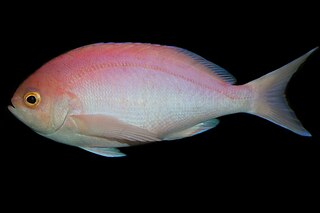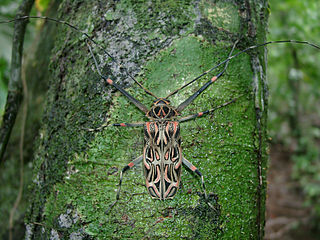
The oceanic whitetip shark, also known as Brown Milbert's sand bar shark, brown shark, lesser white shark, nigano shark, oceanic white-tipped whaler, and silvertip shark, is a large pelagic requiem shark inhabiting tropical and warm temperate seas. Its stocky body is most notable for its long, white-tipped, rounded fins.

Yixianosaurus is a maniraptoran theropod dinosaur genus from the Early Cretaceous of China.

Acragas is a genus of jumping spiders that was first described by Eugène Louis Simon in 1900. The name is derived from the Greek name of Agrigentum, an ancient city on Sicily.

Cheliferoides is a genus of jumping spiders that was first described by Frederick Octavius Pickard-Cambridge in 1901. As of June 2019 it contains only three species, found only in Guatemala, Panama, and the United States: C. longimanus, C. planus, and C. segmentatus.
Lagnus is a spider genus of the jumping spider family, Salticidae. It occurs only in the Philippines and Fiji.

The pink maomao, also known as the longfin perch, is a species of marine ray-finned fish, a member of the subfamily Anthiinae which is part of the grouper and sea bass family Serranidae. It is found in the southern Pacific and the southeastern Indian Ocean.

Auchenipterichthys is a genus of driftwood catfishes found in South America.

The long-winged tomb bat is a species of sac-winged bat in the family Emballonuridae.
Amolops longimanus is a species of frog in the family Ranidae that is found in Myanmar and possibly China.

Bythotrephes longimanus, or the spiny water flea, is a planktonic crustacean less than 15 millimetres (0.6 in) long. It is native to fresh waters of Northern Europe and Asia, but has been accidentally introduced and widely distributed in the Great Lakes area of North America since the 1980s. Bythotrephes is typified by a long abdominal spine with several barbs which protect it from predators.

Euophryini is a tribe of jumping spiders. It has also been treated as the subfamily Euophryinae.

The harlequin beetle is a tropical longhorned beetle native from southern Mexico to Uruguay. The harlequin beetle feeds on sap and is given this name because of its elaborate pattern of black, red and greenish yellow markings on the wing covers of both sexes. The species name longimanus is a Latin word that refers to the extremely long forelegs (manus) of the males, which are usually longer than the beetle’s entire body. As an adult, the species is very large, with a body that can measure nearly 76 mm in length. It is also famous for carrying pseudoscorpions as a form of phoresy.

Monocentropus is a genus of tarantulas that was first described by Reginald Innes Pocock in 1897. As of March 2020 it contains three species, found on Madagascar and in Yemen: M. balfouri, M. lambertoni, and M. longimanus.

Caprodon is a small genus of fish belonging to the subfamily Anthiinae. It contains three species.

Acragas longimanus is a species of jumping spider in the genus Acragas. It was first described in 1900 by Eugène Simon. These spiders are found in Brazil.
Epidius is a genus of crab spiders that was first described by Tamerlan Thorell in 1877. It is a senior synonym of Pothaeus.
Lagnus monteithorum is a jumping spider species in the genus Lagnus. The female was first identified in 2008 by Barbara Maria Patoleta.

Cheliferoides longimanus is a species of jumping spider in the family Salticidae. It is found in the United States.
Pellenes longimanus is a species of jumping spider in the family Salticidae. It is found in the United States.
The Crozet scad is a species of jack mackerel from the family Carangidae, the jacks, pompanos and trevallies, which is found off oceanic islands and over banks and sea mountains in the south east Atlantic and south western Indian Oceans.











